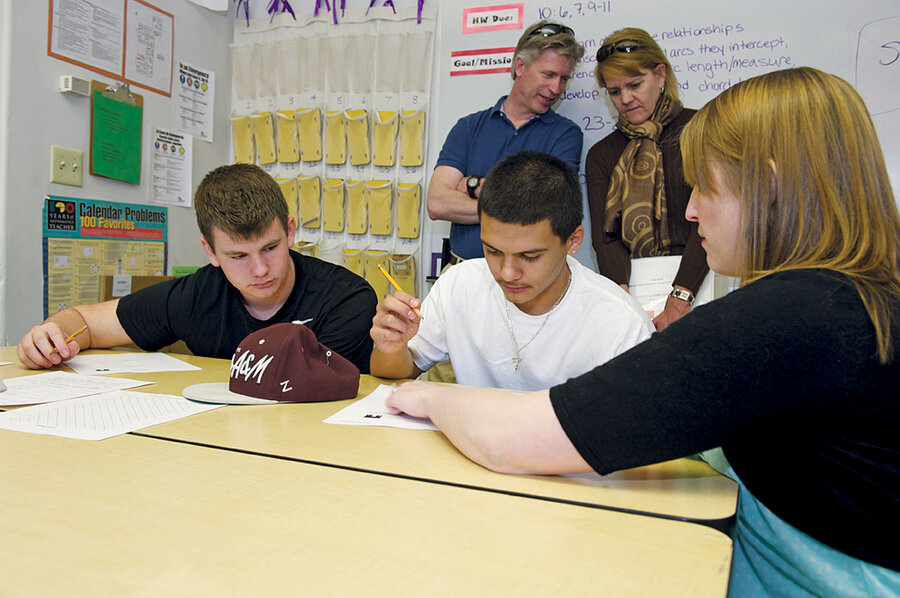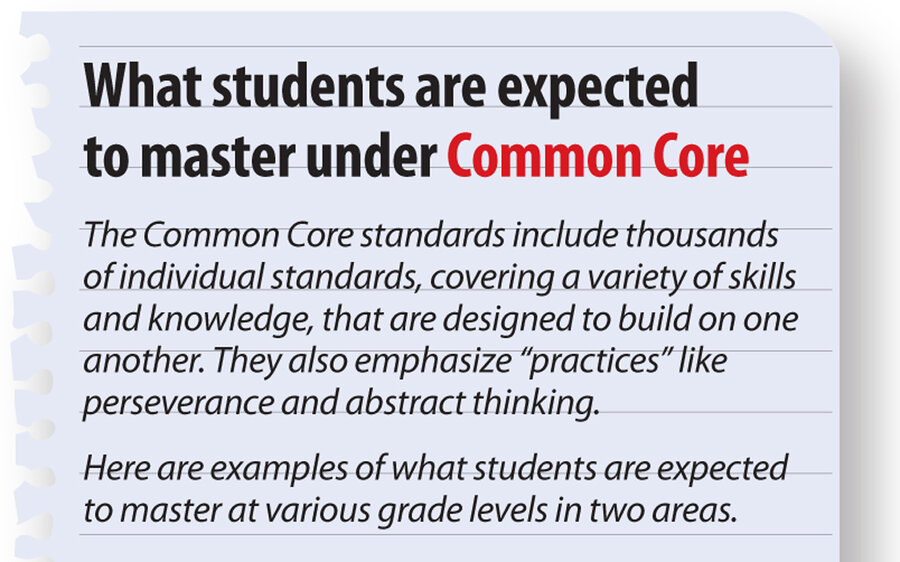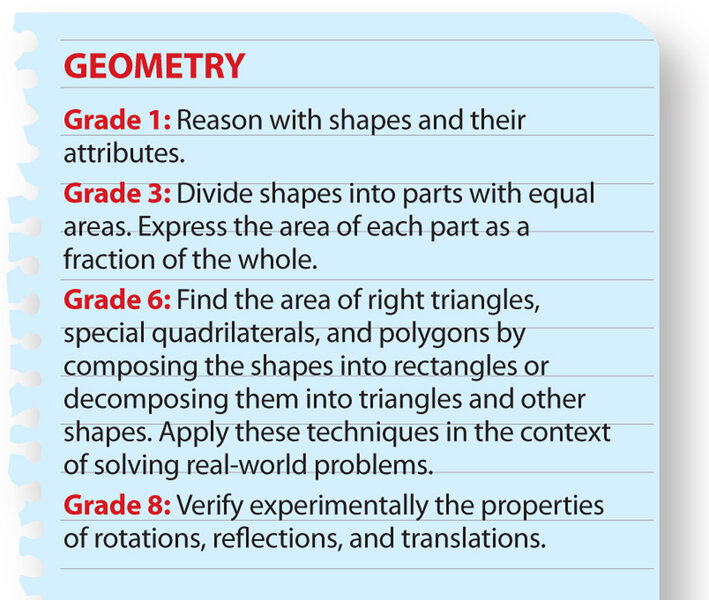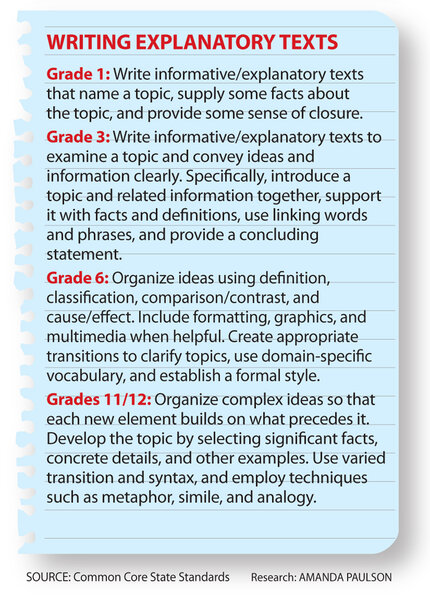Education reform's next big thing: Common Core standards ramp up
Loading...
| Loveland, Colo.
In an Algebra I class at Mountain View High School, a freshman girl is struggling with a new assignment: The students are working in small groups to try to find the number of different-shaped tiles needed to cover a certain size tabletop – and then how to find a pattern and extrapolate on that answer for other sizes.
"Is this supposed to be hard or easy?" she asks her teacher in frustration.
"It's supposed to make you think," replies Kristina Smith, the teacher, as she patiently circles through the room, responding to each student's questions not with an answer but with additional questions that encourage them to push themselves to the next step.
What's going on at this school in Loveland, Colo., as well as across the United States, is a key step in a long-running shift to national standards. These Common Core standards, which have been adopted by 45 states, have the potential to drastically change curriculum in elementary, middle, and high schools around the country.
In a crowded field of major K-12 education reforms, the shift to new, common standards is one of the biggest. Depending on whom you talk to, it's the most promising education reform in decades – an opportunity for teachers to delve more deeply into material and focus on critical-thinking skills and comprehension. Or, it's yet another reform that's being pushed through too quickly, paired with too many high-stakes consequences, and it will further drive teachers from the classroom and discourage kids.
The true test, both proponents and detractors agree, will come over the next year or two, when the standards shift from just existing on paper to becoming a reality in classrooms. Right now, teachers and administrators are discussing how to translate the standards into practice, which are in various stages of implementation. It's a state-by-state and district-by-district process, with many different approaches.
"The hope for Common Core, if it's implemented well, is that we'll have students who are having a K-12 education that has math and literacy make more sense to them, and a smoother process from grade to grade. And that ultimately, when kids graduate from high school, they are better prepared for courses they're going into in their first year in college or whatever job they go into," says Carrie Heath Phillips, director of Common Core standards for the Council of Chief State School Officers (CCSSO), which helped lead the push for the standards. But, Ms. Heath Phillips cautions, "like any initiative, how this ends up being taught, how it's implemented at the local level – that is everything."
The Common Core initiative has been in the works for some time. A state-led effort, it began in 2009, fueled by the CCSSO and the National Governors Association. Kentucky was the first state to officially adopt the standards, in 2010, followed by 44 other states and the District of Columbia. The only states not to adopt the standards are Alaska, Nebraska, Texas, and Virginia. (Minnesota adopted the English standards but not the math standards.)
Prior efforts to set common national standards had failed, in part because they came from the federal government rather than from the states themselves. The hope this time was to have rigorous standards that cross state boundaries and that are coherent across grade levels and subjects – allowing students to build from year to year on prior understanding.
Former standards in many states "were a mile wide and an inch deep," says Heath Phillips. "We're trying to go to the opposite – a few inches wide but a mile deep. We're trying to build those critical-thinking and problem-solving skills, and students' ability to apply those in various real-world situations."
Still, the standards are seeing a fair amount of backlash – some of which, say observers, is primarily due to bad messaging or misunderstandings: people equating standards with standardized testing, for instance; assuming national standards means a national curriculum; or thinking that the standard that 70 percent of texts be informational by 12th grade means English classes will no longer focus on fiction (the standard actually applies across courses, and the intent is for social studies and science classes to do more literacy work).
But some of the backlash is also due to concerns about how standards that may look good on paper will be implemented.
"When you first introduce the concept of Common Core to teachers who have been beaten down by ... drilling kids for testing, they are extremely excited," says Linda Darling-Hammond, an education professor at Stanford University in California. "It's what people want for their own children. But that excitement is very quickly followed by fear and dread, because the ways in which it's going to be used are unknown. If it gets squeezed back into the old multiple-choice testing mentality as a tool for rewards and sanctions, and not a tool for classrooms to engage with more rewarding and challenging instruction, then teachers will turn against it."
Some educators already have.
Diane Ravitch, an education historian and New York University professor, is a frequent critic of accountability reforms, but was initially supportive of the idea of national standards. She's turned against Common Core – in large part, she says, because of the process by which the standards were created and the speed with which they're being implemented.
"No one wanted to give it a trial, and now we're trying it in 46 states," Ms. Ravitch says. "How do we know it will improve achievement? We haven't tried it. How do we know it will work in real classrooms?"
Ravitch also has concerns about the appropriateness of the standards in lower grades – a concern shared by some early-childhood experts. The methods for arriving at standards, working backward from what high school graduates should be expected to know, in some cases has resulted in standards that don't take into account how young children learn, such experts say.
Moreover, the timing of the standards – along with numerous other accountability reforms – couldn't be worse, Ravitch says.
"American public education is being stretched to the breaking point," she says. "If someone is struggling with a 30-pound thing on their back, do you say, carry another 35 pounds because this is good for you?"
That concern is one shared by many teachers, as well as their union leaders. Randi Weingarten, president of the American Federation of Teachers (AFT), praised the Common Core standards in an April 30 address, even as she called for a moratorium on high-stakes consequences while they're being implemented.
In a recent poll of AFT members, Ms. Weingarten noted, 75 percent supported the standards, which she said should mean "less memorization, less racing through a course of study, and more searching for evidence and conceptual understanding."
But in too many cases, including New York, Weingarten said, tests that are aligned with the standards are being fast-tracked before the standards have even begun to be implemented – on material students have never learned. And too many high-stakes consequences are being tied to those tests, she said.
Officials, Weingarten said in her speech, are seeking "to make [the standards] count before they make them work."
Advocates of Common Core also emphasize how important it is to do the implementation well.
"I think there is a growing backlash against standards and accountability-driven reform. This is basically our last shot to get this right," says Kathleen Porter-Magee, senior director of the High Quality Standards Program at the Thomas B. Fordham Institute, a conservative education think tank headquartered in Washington. "Speed should be secondary to thoughtfulness and deliberateness."
Here in Colorado, educators have been central to the transition to the new standards – and many are welcoming them.
The state brought more than 500 teachers together last fall to translate the standards into curriculum and materials that could be shared. This spring, the state is conducting workshops with more teachers around the state; over the summer, teachers will gather to further develop the materials, with special attention on how to improve instruction for particular groups, including special-education and gifted students and English-language learners. This is in addition to district-led efforts going on around the state.
Thompson School District, which includes Mountain View High School, is one of 13 districts working with the Colorado Legacy Foundation. Those districts are doing even more work around integrating new standards (which in Colorado include not just the Common Core ones, but also new state standards in social studies and science) and helping teachers develop curriculum. They've been holding multiple lesson studies like the one Ms. Smith was running, observed by teachers and administrators who later discuss what they saw, share ideas, and talk about what worked.
"It's no longer just about skills: It's about coherence, and how do these concepts flow from grade to grade and course to course, and about rigor," says Smith, who has been teaching math for seven years and welcomes the changes. "My concern is if [we can] accomplish what we need to accomplish in the short period we have, but then I say we don't have any choice."
Lessons like the one she was teaching about tiles, she says, are valuable since they emphasize process and understanding, rather than memorization of an equation.
"I didn't care what [students] gave me as the final answer," she says. "I wanted to see the math they gave me as the process.... My goal was to get them to back up their answer."
In a class downstairs, as part of the same lesson study, Tiffany Utoft is giving her Algebra II students the same problem. The change in the students' understanding and the sophistication of their responses compared with that of the Algebra I students – many develop complicated formulas to solve the problem – are striking.
"I just had an epiphany!" yells Lizzy Fanning, a sophomore with curly red hair, at one point.
The exercise, she says, is a good one since it's so tangible. "When you're learning math, everyone asks how could this apply in real life," Lizzy says. "If you were a carpenter, you could have to do what we're doing now."









